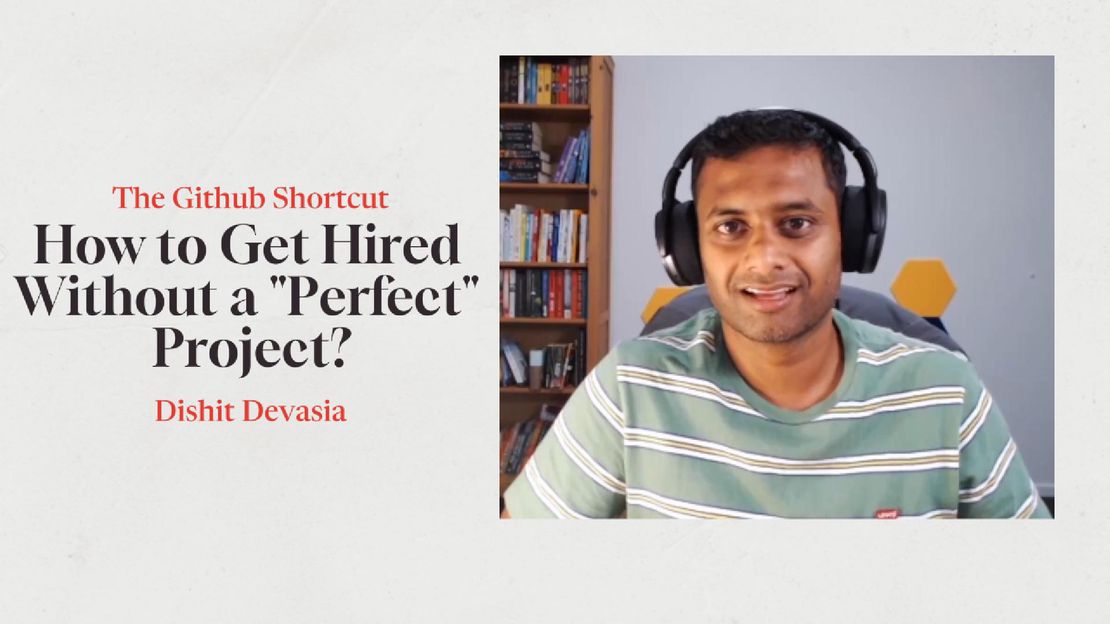
The Real Reason You’re Getting Rejected in Tech Interviews (It’s Not Your Skills)
- Dishit Devasia
- Resume , Career , Interview , Star
- May 17, 2025
Table of Contents
You’ve spent years building your skills.
You’ve put in the late nights, the weekends, the debugging marathons. You’ve solved real problems, learned new tech, and stayed ahead of the curve.
But when it comes to interviews?
You feel stuck.
You give answers you know are technically sound. You talk about the work you’ve done. You try to be clear and confident.
And yet, the rejections keep coming.
Sometimes you get ghosted.
Sometimes you get told someone else was a “better fit.”
But deep down, you know the truth:
It’s not because you’re not good enough.
It’s because your answers did not resonate with the answers interviewers were expecting.
And that’s the part no one teaches you.
How to explain your thinking?
How do you tell the story behind your code without missing technical details?
How do you show value without sounding like you’re bragging or reciting from a textbook?
The worst part?
If you don’t fix this, you could stay stuck here.
Interview after interview. Job after job.
Watching less experienced people land roles you deserve.
Not because they’re smarter. But because they know how to talk like someone who belongs.
In this post, you’ll discover the three silent mistakes most developers and QA engineers make in interviews and how to fix them fast. Before they quietly kill your next opportunity, too.
Mistake 1: Not doing the right type of preparation
Most people focus on learning the technical details they may not know or trying to brush up on some areas they might have forgotten.
However, very few people focus on what they have put in their resumes.
One key question is, “Give me a brief overview of yourself.” This is one of the first questions and is almost always given in most interviews.
Many people do not prepare for it. Some give a summary that tells nothing more than a CV, while others, still focused on remembering things they might get asked, ramble on without a beginning or ending.
Other common questions are likely to be asked, and it is better to prepare for them so that you can make a powerful impression.
Some of them include:
What are your strengths and weaknesses?
- How do you overcome challenges at work?
- What problems have you encountered in your past/current organisation?
- What is one thing you do not like about your past/current organisation that you would like to improve?
- How do you stay updated with technology advances?
Mistake 2: Treating the interview as a quiz instead of a conversation
As an engineer, you will always want to showcase your technical knowledge. So it makes us answer the question as fast as possible. Sometimes, we don’t even wait for the interviewer to finish the question.
Now this has a few problems.
It comes across as if you have memorised the answers. Competent people do not need to memorise the answers. They can pull the answer out of experience rather than memory.
The interviewer will feel that you have not listened to their questions completely, making the interviewer feel not in sync with you. You might come across as a person not open to listening.
With the focus on answering fast, you forget to provide the nuance that the answer might have.
The interviewer might assume that you are not aware of the nuance (which will kill your chances) or might ask follow-up questions, and you may or may not get the nuance that the interviewer was looking for.
Mistake 3: Not referencing your answers with experience
Interviewers want to know about you and your experience. So when you answer a technical question without referencing your experience, you are giving away the opportunity to talk about your deep technical knowledge.
The interviewer is not looking for the technical answer, whether you know it or not.
They are looking for your experience in solving the problem.
For example, consider the question: In SpringBoot, what is the difference between the @Controller and @RestController annotations?Now the answer is straightforward.
@Controller is used to define a web controller that returns views (like JSP or Thymeleaf), while @RestController is a convenience annotation that combines @Controller and @ResponseBody, making it return JSON or XML directly from all methods by default. Use @RestController for APIs, and @Controller for web pages.
But if you answer it with an example from your experience.
@Controller is used to return a view and is typically used with something like Thymeleaf. I’ve used @RestController when building REST APIs. The nice thing is, I don’t need to add @ResponseBody to each method. It automatically converts the return value into JSON. So whenever I’m building a REST API, I just use @RestController.
This gives your interviewer a perspective that you have worked on it and have not repeated some answers that you memorised.
How to avoid these mistakes?
To avoid these pitfalls, you need to understand the different buckets of questions.
3 Question Buckets
Most candidates focus heavily on technical questions when preparing for software engineering interviews.
However, interviewers evaluate you on more than just your coding ability.
Based on my 15+ years of experience and being on both sides of the table, I find it helpful to divide interview questions into three main buckets, each with its own subtypes and preparation strategies.
Common Interview Questions
These questions aren’t meant to test your technical depth. They’re designed to understand your motivation, personality, and communication skills.
Often asked at the beginning of an interview, these questions help set the tone and offer the interviewer a glimpse into how you see yourself.
Examples:
- Tell me about yourself.
- What are your strengths and weaknesses?
- Why are you looking for a change?
- Where do you see yourself in 5 years?
How to prepare?
Create a draft of these answers and practice them before a camera. Tweak answers as you feel the right words that work for you.
Once you have mastered it, the words will come naturally from you.
Your answer will become to the point, and you will deliver it with confidence that will make a good impression, especially with the first question: tell me about yourself.
Technical Interview Questions
This is the meat of most interviews, especially for engineering roles. But not all technical questions are created equal. You can further break them into three subtypes, each requiring a different mindset to effectively approach them.
Fact-Based Questions (Assessing Knowledge)
These questions test your understanding of specific technologies, tools, or concepts. The answers are usually short and have a “correct” answer.
Examples:
- What does @AutoConfiguration do in Spring Boot?
- What is a RESTful API?
- What’s the difference between HashMap and ConcurrentHashMap?
How to prepare?
The trick here is to answer the question by adding scenarios you used in your experience.
If you have used it before, highlight specific examples of how you have used it before and also talk about some of the challenges you have faced.
If you don’t have experience, answer the question and tell them you have never used it.
This prevents further questions about topics you might not know, and the interviewer will move towards a topic you are familiar with.
Opinion-Based Questions (Assessing Preferences and Thought Process)
Here, interviewers are interested in how you form opinions, make trade-offs, and justify your choices. There may be no single “correct” answer, but they want to see if your thinking is grounded and experience-driven.
Examples:
- Do you prefer SQL or Nosql databases? Why?
- Would you introduce a new language like Python in a Java-heavy codebase?
- What’s your take on using microservices vs. monoliths?
How to prepare?
These are tricky, as you might not know if the interviewer dislikes one part of it. The idea is to provide your opinions and give examples if you have them.
You can also reference blogs if you don’t have enough proof of experience.
In either case, the critical piece is the ending. You finish it by saying your experience or learning limits your thoughts, and you are open to ideas that will help you learn better.
This helps you get pointers if the interviewers have strong opinions about it and also showcases that you are open to feedback and learning.
Scenario-Based Questions (Assessing Application and Design Skills)
These practical, open-ended questions test how you think through real-world problems, design systems, or debug tricky issues. They simulate the kind of challenges you’d face on the job.
Examples:
- You’re asked to build a REST API—what are the key things you’d consider?
- How would you debug a slow-performing endpoint?
- How would you handle consistency if multiple microservices need to share the cache?
Behavioural Questions (The Culture Fit Test)
Behavioural questions assess how you work with others, deal with conflict, handle pressure, and grow from challenges. These are crucial for determining whether you’d fit the team and company culture well.
Examples:
- How do you handle tight deadlines?
- What would you do if you’re blocked and not getting the needed information?
- Tell me about when you received difficult feedback and how you handled it.
How to prepare?
Similar to common interview questions, the questions are limited. So you can prepare well for these.
You need to use the STAR technique to answer these questions.
If you can master this technique, you can also answer your technical questions with this approach.
The benefit is that this approach makes you tell a story. Now, the story might not be the best story in the world, but it will be enough to hook the interviewer’s attention.
It also gives the interviewer opportunities to ask questions, and since you are basing it on your experience, you will always be on firmer ground than with other questions.
The STAR framework provides structure:
- Situation: What was the context?
- Task: What needed to be done?
- Action: What did you do?
- Result: What was the outcome?
Final Thoughts: Turn Preparation into Confidence
If there’s one thing to take away from this, great interviews don’t begin in the interview room.
They start with how you prepare.
- Prepare answers to common and behavioural questions ahead of time—not to memorise, but to internalise.
- Anchor your responses in your past experience. That’s where your strengths live.
- Use the STAR technique to draw out scenarios in advance. The more you practice these, the more naturally they’ll come to you when it matters.
- Don’t just say your answers. Practice them on a video call. Record. Rewatch. Adjust. This one step alone can drastically improve how you come across.
When you combine clear structure with authentic storytelling and real-world examples, your interviews start feeling less like an interrogation and more like a conversation you’re ready for.
Want help putting this into action?
Join me for the upcoming free live workshop:
3 Interview Mistakes Devs and QA Engineers Make That Sabotage Interviews (And How to Fix Them Fast).
I’ll discuss real-world examples, live breakdowns, and simple techniques you can use immediately, even if your following interview is tomorrow.
